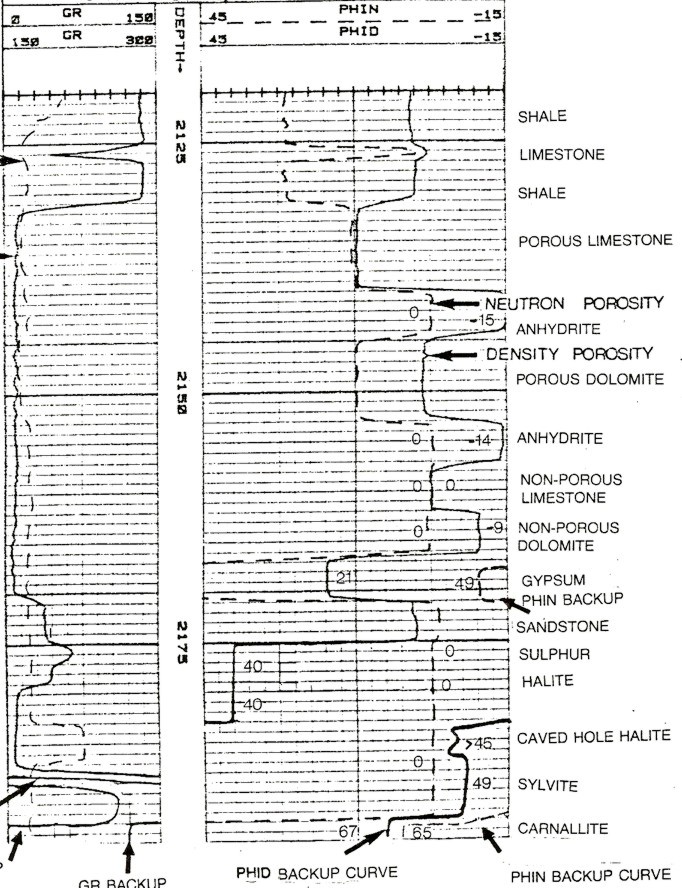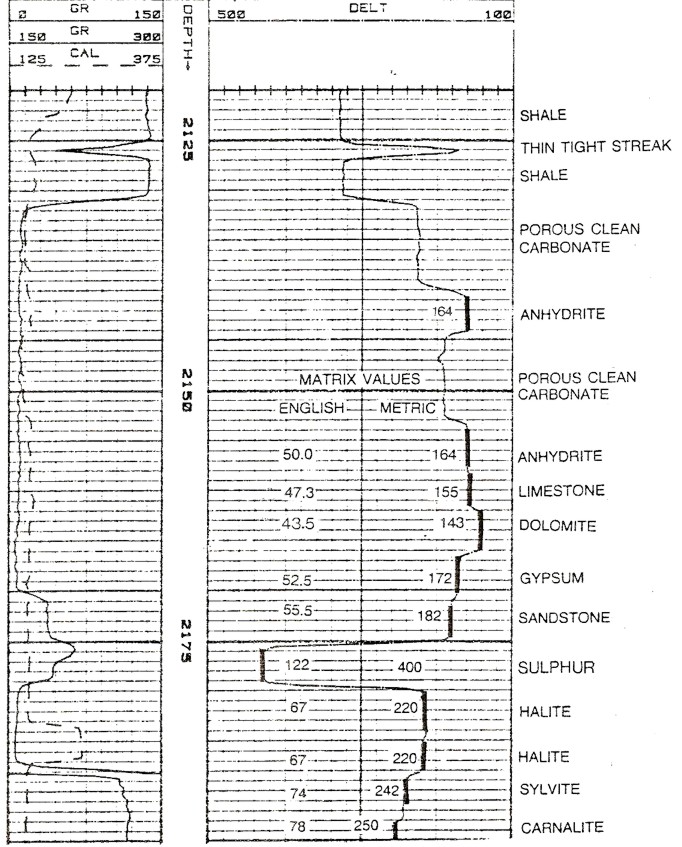|
 SP-GR-RESISTIVITY RULES
SP-GR-RESISTIVITY RULES
These rules are the basic set for segregating
shales from other rock types. Pure shales are seldom zones of
interest as oil and gas reservoirs, although many rocks that
have been traditionally called "shales" are really silty or
sandy shales. These are now zones of interest as "shale gas"
reservoirs. Pure shales may be hydrocarbon source rocks and are
interesting in different ways than reservoir rocks.
Crain’s Rule #0:
Gamma ray or SP deflections to the left indicate cleaner
sands, deflections to the right are shaly. Draw clean and
shale lines, then interpolate linearly between clean and
shale lines to visually estimate Shale Volume (Vsh).
Shale beds are not “Zones of Interest”.
Everything else, including very shaly sands (Vsh < 0.75) are interesting. Although a zone may
be water bearing, it is still a useful source of log analysis
information, and is still a zone of interest at this stage.
Clean and shaly sands have been marked on the logs shown below
(Layers A, B, and C). Everything else are shale beds.
To find clean zones versus shale zones, examine
the spontaneous potential (SP) response, gamma ray (GR)
response, and density neutron separation. Low values of GR,
highly negative values of SP, or density neutron curves falling
close to each other usually indicate low shale volume. High GR
values, no SP deflection, or large separation on density neutron
curves normally indicate high shale volume. Young shales have
low resistivity (1 to 4 ohm-m), older shales have medium
resistivity (5 to 25 ohm-m). Shale source rocks have higher
resistivity (25 to 250 ohm-m) and usually have extra high GR
(150 to 300 API units).
 
Annotated logs showing layers picked on the basis of shale
volume. Layer A is a very shaly sand, Layers B and C are clean
sands. The layers above A, and between A and B, and below C are
shales with medium resistivity (about 20 ohm-m), moderately high
GR (100 -120 API units), and SP on the right side of the log
track (zero deflection to the left). Clean and shale lines are
drawn on the SP and GR logs. Clean lines on the GR can be
anywhere between 7 to 45 API units and typically between 15 and
30 API units.
 NEUTRON DENSITY SEPARATION
RULES
NEUTRON DENSITY SEPARATION
RULES
These rules are intended to segregate clean rocks
into various common minerals, typically quartz, calcite,
dolomite, anhydrite, and halite. These are by far the most
common minerals in sedimentary rocks. If you prefer rock names,
the rules will distinguish sandstone, limestone, dolostone,
anhydrite, and rock salt - same stuff, alternate names.
 Crain’s Rule #6:
Crain’s Rule #6:
On Limestone Units logs, the density neutron separation for
limestone is near zero, dolomite is 8 to 12 porosity units,
and anhydrite is 15 or more. Sandstone has up to 7 porosity
units crossover.
On
Sandstone Units logs, separation for sandstone is near zero,
limestone is about 7 porosity units, dolomite is 15 or more,
and anhydrite is 22 or more.
Visual determination of lithology (in addition to
identifying shale as discussed earlier) is done by noting the
quantity of density neutron separation and/or by noting absolute
values of the photo electric curve. The rules take a little
memory work.
You must know whether the density neutron log is
recorded on Sandstone, Limestone, or Dolomite porosity scales,
before you apply Crain’s Rule #6. The porosity scale on the log
is a function of choices made at the time of logging and have
nothing to do with the rocks being logged. Ideally, sand-shale
sequences are logged on Sandstone scales and carbonate sequences
on Limestone scales. The real world is far from ideal, so you
could find any porosity scale in any rock sequence. Take care!
 SANDSTONE SCALE LOG
SANDSTONE SCALE LOG

Sand – shale identification from gamma ray and
density-neutron separation. Small amounts of density neutron
separation with a low gamma ray may indicate some heavy minerals
in a sandstone. Most minerals are heavier than quartz, so any
cementing materials, volcanic rock fragments, or mica will cause
some separation. Both pure quartz (no separation) and quartz
with heavy minerals (some separation) are
seen here.
 LIMESTONE SCALE LOG
LIMESTONE SCALE LOG

Lithology identification is accomplished by
observation of density neutron separation and the gamma ray
response, along with a review of core and sample descriptions.
Here, calcite, dolomite, and anhydrite layers are easy to see
based solely on their neutron density separation values and the
corresponding clean GR curve.
 PE-GR-DENSITY NEUTRON RULES
PE-GR-DENSITY NEUTRON RULES
The photoelectric effect is often a direct
mineralogy indicator..
 Crain’s Rule #7:
Crain’s Rule #7:
PE below 1 is coal, near 2 is sandstone, near
3 is dolomite or shale, and near 5 is limestone or
anhydrite. The high density (negative density porosity) of
anhydrite will distinguish anhydrite from limestone. High
gamma ray will distinguish shale from dolomite.
  SUMMARY
OF LITHOLOGY RULES
SUMMARY
OF LITHOLOGY RULES
ROCK
N–D N–D PE GR
(SS) (LS)
SAND 0 - 7 2 LO
LIME 7 0 5 LO
DOLO 15+ 8+ 3 LO
ANHY 22+ 15+ 5 LO
SALT - 37 - 45 4.5 LO
SHLE 20+ 13+ 3.5 HI
Memorize this table, or keep a copy in your wallet. Practice
the skill and use it in your daily work.
THINK
LIKE A DETECTIVE:
1. Find the evidence
2. Assess the evidence
3. Postulate all possibilities
4. Eliminate the impossible
5: Select the answer that fits best with the evidence
Remember:
logs are not perfect and these rules are not perfect. Adjust
the rules to suit your experience. Mineral mixtures are
common, so think in terms of what is possible in each case.
On the
log at the right, the evidence and conclusion is shown for 6
layers with different lithology.
This is a LIMESTONE scale log 
 RULE EXCEPTIONS:
RULE EXCEPTIONS:
High GR log readings coupled with density neutron
log readings that are close together, are a sign of radioactive
sandstone or limestone. To tell radioactive dolomite zones from
shale zones, use a gamma ray spectral log, since the density
neutron log will show separation in both cases. The PE value can
help differentiate between radioactive dolomite and chlorite
shale but not between dolomite and illite rich shale. High
thorium values on the gamma ray spectral log indicate the shale.
 SONIC DENSITY NEUTRON GR RULES
SONIC DENSITY NEUTRON GR RULES
A combination of neutron density separation
rules, plus some "absolute value" rules can be used to identify
evaporite minerals. An example is shown below, in which the absolute
values for some pure minerals are shown. Some mineral mixtures may
be identified by intermediate absolute values plus some local
knowledge.

Absolute values of neutron and
density porosity for some pure minerals - these are particularly
useful for evaporite minerals. Note the backup scales that are
needed pr density, neutron, and GR curves that are required to
handle some of these minerals

Absolute values of sonic log for some minerals - same
sequence as previous illustration. Numerical algorithms for solving
2 and 3 mineral models are given elsewhere in this Handbook.
 ABSOLUTE VALUES OF LOG readings (and some derived terms) FOR
SOME PURE MINERALS
ABSOLUTE VALUES OF LOG readings (and some derived terms) FOR
SOME PURE MINERALS
*
PHINMA DENSMA DELTMA MLITH NLITH
PE UMA
Clean Quartz –
0.028 2650 182 0.802
0.623 1.82 4.8
Calcite
0.000 2710
155 0.822 0.585 5.09
13.8
Dolomite
0.005 2870 144
0.769 0.532 3.13 9.0
Anhydrite
0.002 2950 164
0.707 0.512 5.08 15.0
Gypsum
0.507 2350 172 1.002
0.365 4.04 9.5
Mica Muscovite
0.165 2830 155 0.768
0.456 2.40 6.8
Biotite
0.225 3200
182 0.601 0.352 8.59
27.5
Clay Kaolinite
0.491 2640 211 0.753
0.310 1.47 3.9
Glauconite
0.175 2830 182 0.723
0.451 4.77 13.5
Illite
0.158 2770
212 0.696 0.476 3.03
8.4
Chlorite
0.428 2870
212 0.658 0.306 4.77
13.7
Montmorillonite
0.115 2620 212 0.760
0.546 1.64 4.3
Barite
0.002 4080 229
0.383 0.324 261 1065
NaFeld Albite –
0.013 2580 155 0.889
0.641 1.70 4.4
Anorthite
– 0.018 2740 148
0.820 0.585 3.14 8.6
K-Feld Orthoclase –
0.011 2540 226 0.772
0.656 2.87 7.3
Iron Siderite
0.129 3910 144
0.494 0.299 14.3 56.2
Ankerite
0.057 3080
150 0.683 0.453 8.37
25.8
Pyrite
– 0.019 5000 130
0.370 0.255 16.4 82.2
Evaps Fluorite –
0.006 3120 150 0.670
0.475 6.66 20.8
Halite
– 0.018 2030 220
1.172 0.988 4.72 9.6
Sylvite
– 0.041 1860 242
0.295 0.270 8.76 16.3
Carnalite
0.584 1560
256 1.959 0.743 4.29
6.7
Coal Anthracite
0.414 1470 345 1.757
1.247 0.20 0.3
Lignite
0.542 1190
525 1.460 2.411 0.25
0.3
|

